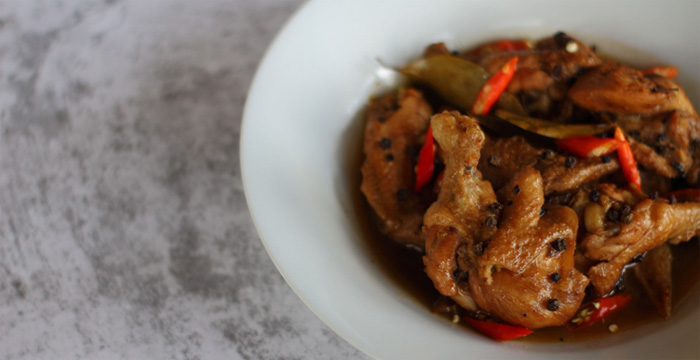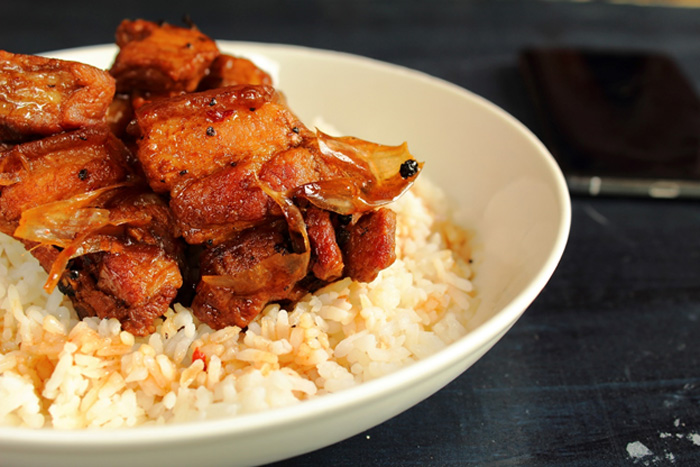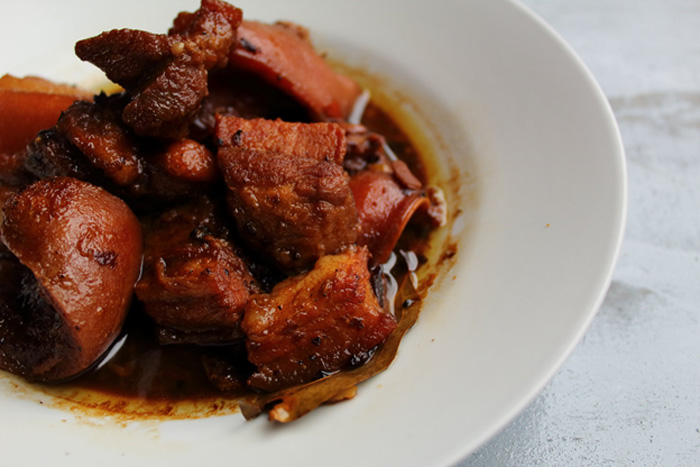The carrying out of community quarantine prompted some of us to avail the work from home scheme. Aside from sticking with the targets and sending off accomplishment ...
https://cleanspoonchronicle.wordpress.com/
The carrying out of community quarantine prompted some of us to avail the work from home scheme. Aside from sticking with the targets and sending off accomplishment reports, most of us must have been cooking regularly (or intermittently) and are already a self-confessed cook by now. We make the most of whatever resources available since the majority of us have limited exposure outside and are discouraged from leaving home.
Like my family and everyone else, we are not prepared for a coronavirus lockdown. Some of our gardens were already empty from last month’s harvest. Our kitchen not well stocked. We do some grocery often but buying only what we need. And because of the onslaught of covid-19, staying home is our best bet to safety and wellness.
For years, the country’s farmers, food producers, and the agriculture sector at large have been urging us to join their cause. To make us food sufficient and secure by planting altogether. Now more than ever, we cherish the value of a well-planted garden and a well-stock pantry or kitchen. This global health crisis prompted us to plant, cook and eat together.
How do we come up with three decent meals a day for weeks at a time with limited access to the outside world? And given our appetite and saturation point---is it possible to keep our meals interesting?
Here, I have enlisted the help of friends here and abroad who happens to be chefs, home cooks, food bloggers, farmers, food lovers, nutritionists and dietician for tips and inspiration:
Phoebe Galeon
Studied Food Science at UP-Diliman
Faculty Member, USTsP
My conversation with Ms. Galeon online was probably the most succinct since she gave direct answers every time I ask her a question. “I would recommend on stocking food items that can be used as either viand or snack, but shelf life extension is necessary if we’re talking here about stocking up.” She went to disclose further that value-adding of farm goods in season is also commendable to avert oversupply and it gives consumers more product options.
“One can start to focus on local and available raw materials. If it is of kitchen scale, then it would be more of bottling in the likes of jams, jellies and pickles but focus on abundant raw resources and materials because what is abundant is cheap.” For vegetables, one can introduce the concept of vacuum packaging, a great technique that remains unexplored for potential value adding.
“Like, if I have abundant harvest of carrots what do I do with it so that I don’t flood the market and cheapen the cost of my produce? I can do minimal processing of my carrots, vacuum-packed it and keep it frozen for future use or future selling. For other sources of carbohydrates like tubers, it can be converted into dried powders for future use.”
For Ms. Galeon, value-adding is integral in prolonging and diversifying our food resources.

June Rey Tunog
Head Chef and in-charge of developing new products and food items for Roy’s Bistro
Chef June Rey was in the middle of making a batch of cakes ready for Mother’s Day in the commissary when he decided to give me a call.
“Dili ko ga-palit ug processed foods sa gawas like sausages or chorizos kay wala ko kabalo sa amount of preservatives and chemicals nga naa ana. If ever I feel like having some, I make them at home. I don’t shy from storing up on noodle-based products or canned goods since admittedly, they are available in the market. But I always make sure I mix or pair them with whatever leafy green vegetables are available at home.”
I also suggest cooking meals which can be stored in the ref and can be reheated during meal time. I cook adobo or humba. If fish is available like bangus, you can also marinate them and cook it for the next meal. The trick is to prepare the dish and have them packed in portion of recommended serving size. If your kids are picky eaters and are not into vegetables, try to incorporate them with other dishes or make a vegetable patty, if say, squash is abundant or are in season. Lumpia and embutido are some of the easy-to-do dishes also which can be stored up for a while.
Paolo Andaya Lumbres
Chef and owner of Butuan City’s popular food joint Food Coma
With a working experience of eight years in the food industry, chef Paolo was quick to point out in identifying pantry size and how big it can stock up. “If you have a small freezer (or refrigerator), essentially you need to stock up more on canned goods. Yes, it’s not that healthy but it is essential for surviving. Now if you have a big freezer space, don’t worry on stocking up meats. As long as it is frozen you don’t need to worry about wasting it.”
He also shared proper ways of storing meats to prevent cross contamination. “Put at the lower level poultry meat like chicken, up a level next will be whole meats like pork or beef. The third layer higher is cut or portioned meats then seafood and on top of them all would be the cooked food items.”
He also shared to plan your meal ahead. Come up with a list so that when you do your grocery mostly that will be your essential ingredients to use from day 1 up until the end of the week. Planning your meal is one way also to save money.
“Speaking of saving money, keep leftover foods refrigerated. Reheat only the portions your family will have during meal time. Always cook the food in the best way possible so that when reheating comes or should you want to transform it into another dish or as fillers, it won’t become soggy or overcooked by then.”

Recarte Bacus
Farm owner, Candiisan Diversified Farm
“Grow your own food. Start with leafy greens as they are fast growers or replant vegetables bought from the market like alugbati and kangkong. Cook dishes good for 3 to 4 meals and place in containers then fridge and reheat in serving size during meal time.” Cart shared over a Facebook messenger conversation as he took a break from farming in the middle of a noonday heat.
“We make our own marinades, dippings, dressings, and sauces as well as teas and juices. Don’t be afraid to try things out and experiment what’s good for your own taste.”
Carte also shared that their leftover rice is turned into fried rice or champorado. As for canned goods, he always adds some vegetables like carrots and potatoes or leafy greens such as malunggay or saluyot.
Jeff Ayento
Apprentice Chef, Culinary Institute of Cagayan de Oro (CIC) alumnus
Juggling schedules between work and as a recipe developer for Winosity at the same time maintaining his blog FoodBuds, Jeff was generous enough to share the following tips for the home cook in all of us:
- Pickling is another way of preserving fruits and vegetables. And can be a great snack or a great appetizer for different purposes such as for grilled meats and fish, or even fried dishes. The basic pickling brine solution is vinegar, sugar, salt and whole black peppers. Adding additional spices would be a great idea.
- Use vinegar or citrus juice as wonderful flavor enhancers but add them at the last moment. Vinegar is great on vegetables, such as greens; and citrus works well on fruits, such as melons. They enhance the flavor notes of the vegetables and fruits and protecting them from oxidation or browning.
- Canned sardines can be a great ingredient to your stir-fried vegetables instead of using chicken or meat. This would create a variation to an ordinary and boring canned sardine.

Beda Shane Abundo
Food Vlogger of “Ramon Sy’s Kitchen”
As Alveo-Ayalaland’s Property Specialist providing quality homes and modern-day living conveniences, a busy family man like Beda Shane takes the time to cook and personally man the kitchen.
In his video blogs, his kitchen essentials include poultry products such as chicken and eggs, pork, fish and other seafood, herbs and spices, as well as noodle-based food items. He even caters food in serving-sized containers like Bicol express and Laing and patrons can just message him online.
“Aside from doing video conferences with my team and colleagues all over the Philippines, I keep myself busy in the kitchen and cater some of my home cooking since I like hearing feedbacks from customers that they liked the food and that it’s also an opportunity to earn while being quarantined at home.”
Melinda Petalcorin
Home cook, Food lover extraordinaire
“This got me thinking and I’m imagining what I have in my kitchen stash right now.” My ambush conversation with Mel made her want to dash home and do a quick look over.
“Come to think of it, I’m into Korean cuisine at the moment since I have more of their ingredients like sesame oil, gochujang, sesame seeds, kimchi (the biggest jar I could find in the grocery) and samjang. I don’t think those are everyone’s kitchen essentials.” she shared replete with a chuckling emoji.
“But my must-haves would have to be flour and cornstarch because you can use for meat and veggies, then herbs and legumes such as mung beans because I can grow them as bean sprouts. Smart move di ba?”
I totally agree with Mel and the rest of the contributor friends above.
The kitchen has always been the heart of the home, but as the coronavirus pandemic rages on, we need to transform our stress to strength. Besides the three meals a day needed during home quarantines and closures, it’s also where our meals are being shared, food for our frontliners being packed, conversations being exchanged, and snacks constantly being cobbled together. That’s where our strength comes from aside from the soul food we whip up.
